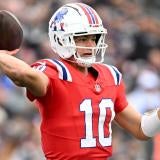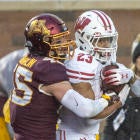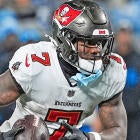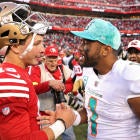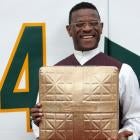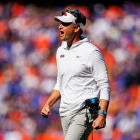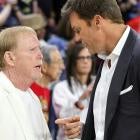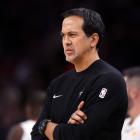If putting your quarterback in position to succeed is the foundation of a successful offense in the modern NFL, finding players who can disrupt the quarterback's rhythm is key to stopping opposing offenses from being successful. Of course, there are two ways to disrupt the quarterback's path to success: affect their pass at the point of the catch, or affect that quarterback at the point of the pass.
We're here to take a look into the guys who do the latter. There are 59 draft-eligible defensive linemen for whom we have available data on either athleticism (3SigmaAthlete.com's version of SPARQ, an approximation of Nike's SPARQ metric for measuring an athlete's Speed, Power, Agility, Reaction, and Quickness) and/or final-year collegiate production (Adjusted Overall Win Rate, a combination of Pro Football Focus' Pass Rush Win Rate and Run Stops, weighted so that pass-rush ability is more valuable than run defense), but only 26 for whom we have both.
In the chart below, the 13 EDGE defenders for whom we have both data sets are denoted with purple icons, while the 13 interior defensive linemen are marked with blue icons. The positional averages for SPARQ and Adjusted Overall Win Rate are similarly denoted with those same colors. Any player above the horizontal lines finished the 2019 season as an above-average playmaker, and anyone below it was below average. Any player to the right of the vertical blue and purple lines tested above positional averages for athleticism at the combine, while anyone to the left of those lines had below-average testing metrics.
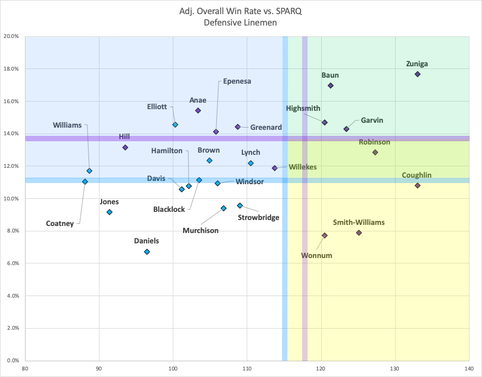
And among that group of players, just four graded out as above-average in both SPARQ and Adjusted Overall Win Rate (highlighted in the green section above). All four players are EDGE defenders, though only one of them is considered a potential first-round prospect.
- EDGE Jabari Zuniga (Florida)
- EDGE Zach Baun (Wisconsin)
- EDGE Alex Highsmith (Charlotte)
- EDGE Jonathan Garvin (Miami)
The four players in the above chart that checked in with above-average SPARQ athleticism grades but a below-average Adjusted Overall Win Rate (highlighted in the yellow section above) also all play on the edge.
- EDGE Alton Robinson (Syracuse)
- EDGE Carter Coughlin (Minnesota)
- EDGE James Smith-Williams (North Carolina St)
- EDGE D.J. Wonnum (South Carolina)
What that means is that every interior defensive line prospect for whom there is available testing and production data graded out as a below-average athlete (highlighted in the blue section above). Four of those 13 players managed above-average production, including probable first-rounder Derrick Brown. The same is true of four edge defenders, including another likely first-round pick in A.J. Epenesa.
- EDGE Jonathan Greenard (Florida)
- EDGE A.J. Epenesa (Iowa)
- EDGE Bradlee Anae (Utah)
- EDGE Trevon Hill (Miami)
- IDL Jordan Elliott (Missouri)
- IDL Derrick Brown (Auburn)
- IDL Raequan Williams (Michigan St)
- IDL James Lynch (Baylor)
And finally, 10 players checked in with below-average scores in both SPARQ and Adjusted Overall Win Rate, with nine of those players lining up on the defensive interior.
- EDGE Kenny Willekes (Michigan St)
- IDL Ross Blacklock (TCU)
- IDL Josiah Coatney (Mississippi)
- IDL Raekwon Davis (Alabama)
- IDL Darrion Daniels (Nebraska)
- IDL Davon Hamilton (Ohio St)
- IDL Benito Jones (Mississippi)
- IDL Robert Windsor (Penn St)
- IDL Jason Strowbridge (North Carolina)
- IDL Larrel Murchison (North Carolina St)
But even all this information still leaves us with 33 players for whom there is available athleticism or production data, but not both.
That group includes the top defensive prospect, Chase Young, who had the highest Adjusted Overall Win Rate (19.9 percent) of anybody at either position. There's damn good reason he's considered the top defender in the class. Right behind Young was Michigan's Josh Uche (19.7 percent), as well as nine more edge defenders who have not yet done enough athletic testing to generate a SPARQ score. Similarly, South Carolina's Javon Kinlaw had above-average production with a 13.6 percent Adjusted Overall Win Rate, second-best among this group of interior defenders behind only Jordan Elliott. He was joined by five additional interior defensive linemen.
- EDGE Yetur Gross-Matos (Penn St)
- EDGE Trevis Gipson (Tulsa)
- EDGE Chase Young (Ohio St)
- EDGE Josh Uche (Michigan)
- EDGE Curtis Weaver (Boise St)
- EDGE Anfernee Jennings (Alabama)
- EDGE Khalid Kareem (Notre Dame)
- EDGE Terrell Lewis (Alabama)
- EDGE Julian Okwara (Notre Dame)
- EDGE Michael Danna (Michigan)
- EDGE Marlon Davidson (Auburn)
- IDL Javon Kinlaw (South Carolina)
- IDL Justin Madubuike (Texas A&M)
- IDL Garrett Marino (UAB)
- IDL Bravvion Roy (Baylor)
- IDL Neville Gallimore (Oklahoma)
- IDL McTelvin Agim (Arkansas)
On the other end of the spectrum was potential first-round pick K'Lavon Chaisson out of LSU. He had considerably below-average production with am 11.0 percent Adjusted Overall Win Rate. But his calling card is his athleticism, so the part of this equation that he would have succeeded in, never actually happened. Among defenders for whom there is available production data but not SPARQ scores, Chaisson is joined by four more EDGE guys and two interior linemen.
- EDGE Oluwole Betiku (Illinois)
- EDGE K'Lavon Chaisson (LSU)
- EDGE Darrell Taylor (Tennessee)
- EDGE Broderick Washington (Texas Tech)
- EDGE Azur Kamara (Kansas)
- IDL Rashard Lawrence (LSU)
- IDL Leki Fotu (Utah)
Lastly, there's the group of players that did athletic testing at the combine but for whom we do not have reliable production data. Among that group, three were above-average athletes and five below-average. None are notable-enough prospects that they'd be showing up in mock drafts, unless they go beyond the first few rounds and onto Day 3.
So, what can we glean from all this data?
First, the EDGE defenders in this class are considerably more athletic than their interior line counterparts. And that's true even after adjusting for positional averages. The interior linemen that did testing are all below-average athletes for their position. Second, there are a bunch of EDGE guys you might be able to take a shot on in the middle-to-late rounds and know you'll be getting a player who is an above-average athlete, above-average producer, or both. None of Zuniga, Highsmith, or Garvin is showing up anywhere near the first round of mocks, for example, and they all sit in the upper-right quadrant of out chart. Anae and Greenard could likely be had on Day 2 or even Day 3, yet they each produced at high levels last season, while Coughlin graded out as the best athlete among the EDGE players who did athletic testing at the combine.
Among interior defensive linemen, however, there are quite a few players who look like they might be relative stay-aways, as they tested and produced at below-average levels. It doesn't help that players like Kinlaw, Madubuike, and Gallimore didn't do athletic testing, but even if we assume they are all above-average athletes (not an unfair assumption), that would still only make three interior linemen in the upper-right quadrant of our chart. Considering the no-testing-data group of EDGE rushers includes guys like Young, Uche, Yetur Gross-Matos, Julian Okwara, and more, it's likely that the gap between EDGE guys and interior defenders would be larger, not smaller.




